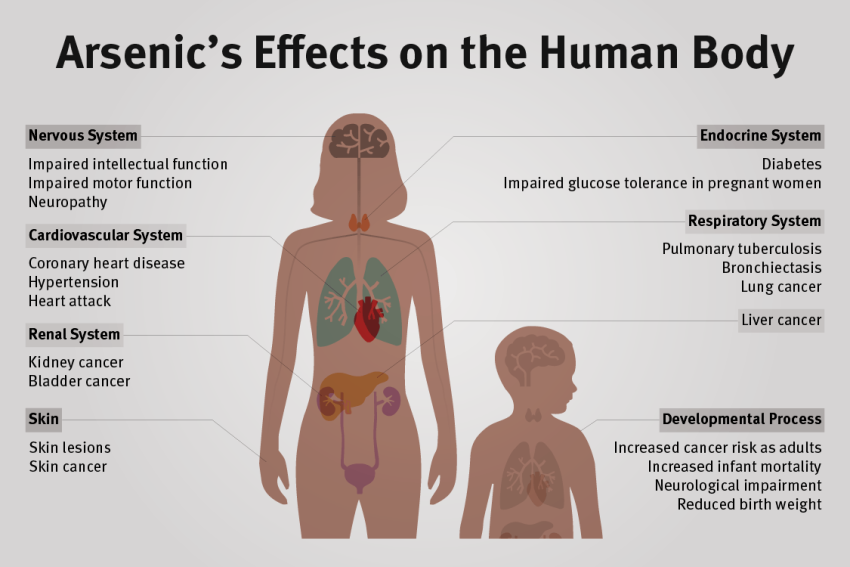Arsenic Exposure Can Mar Cognitive Ability: Study
Context:
Even modest amounts of arsenic consumption may influence cognitive function in children, adolescents, and young adults, according to a recent peer-reviewed study. High levels of arsenic from contaminated groundwater in India have been related to a variety of illnesses.
Arsenic Exposure:
- Arsenic is a naturally occurring element of the earth’s crust and is found in large quantities in the air, water, and land. In its inorganic form, it is extremely poisonous.
- Through drinking contaminated water, using contaminated water for food preparation and crop irrigation, industrial activities, eating contaminated food, and smoking cigarettes, people are exposed to high doses of inorganic arsenic.
- Chronic arsenic poisoning can result from long-term exposure to inorganic arsenic, typically through food and drinking water. The most common side effects include skin blemishes and skin cancer.
Points to ponder:
- According to a new peer-reviewed study, children, teenagers, and young adults who consume even little amounts of arsenic may experience cognitive impairment.
- According to the study, people who had been exposed to arsenic had less grey matter in their brains, which is essential for cognitive processes.
- Key areas of the brain involved in focus, task switching, and temporary information storage were shown to have weaker connections.
- According to the experts, long-term exposure to arsenic may result in a “silent pandemic” that might harm a sizeable section of the world’s population.
- Arsenic exposure is particularly detrimental to underprivileged communities, according to earlier studies.
- Urine samples from 1,014 individuals in India were analysed as part of the study to determine their exposure to arsenic.
- Brain imaging was utilised to show the various parts of the brain while a battery of computerised tests evaluated cognitive function.
- While there was little evidence that arsenic affected cognition on an individual basis, this effect became more obvious when looking at humans as a whole.
- The study’s primary objective was to examine how many environmental and biological factors affect young people’s neurological and cognitive development. This broader examination led to the discovery of the connection between arsenic exposure and brain function.
- The impact of other environmental factors, such as air pollution, will also be examined in additional experiments as the researchers continue to look at how much arsenic impacts the brain.
- Governments in afflicted areas, like those in India’s Bihar and West Bengal, have put plans in place to deal with arsenic poisoning. These include encouraging piped water access rather than groundwater extraction and constructing arsenic treatment facilities.
Prevention and Way Forward
- Replace sources with high levels of arsenic, such as groundwater, with sources low in arsenic and safe for microorganisms, such as rainwater and treated surface water. While high-arsenic water can be used for various things like bathing and washing clothes, low-arsenic water can be used for drinking, cooking, and irrigation.
- Make a distinction between sources with high and low arsenic levels. For instance, check the amount of arsenic in the water and paint hand pumps or tube wells a different colour. When combined with adequate education, this can be a powerful and affordable way to quickly limit exposure to arsenic.
- To reach a safe level of arsenic concentration, mix low-arsenic water with higher-arsenic water.
- Install centralised or household methods for removing arsenic, and make sure the extracted arsenic is disposed of properly. Technologies for removing arsenic include membrane, oxidation, coagulation-precipitation, absorption, and ion exchange processes. There are more and more affordable and efficient ways to get rid of arsenic from small or household items, but there is currently no proof that these methods work when used for extended periods.





